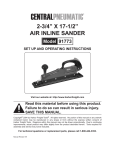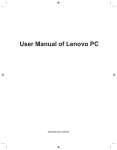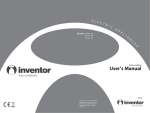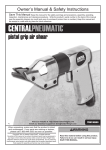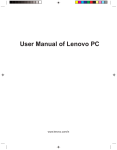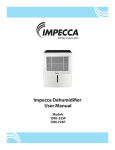Download Harbor Freight Tools 68152 User's Manual
Transcript
NOTICE is used to address practices not related to personal injury. SAVE THIS MANUAL Keep this manual for the safety warnings and precautions, assembly, operating, inspection, maintenance and cleaning procedures. Write the product’s serial number in the back of the manual near the assembly diagram (or month and year of purchase if product has no number). Keep this manual and the receipt in a safe and dry place for future reference. CAUTION, without the safety alert symbol, is used to address practices not related to personal injury. General Power Tool Safety Warnings WARNING Read all safety warnings and instructions. Failure to follow the warnings and instructions may result in electric shock, fire and/or serious injury. Save all warnings and instructions for future reference. IMPORTANT SAFETY INFORMATION In this manual, on the labeling, and all other information provided with this product: 1. a.Keep work area clean and well lit. Cluttered or dark areas invite accidents. This is the safety alert symbol. It is used to alert you to potential personal injury hazards. Obey all safety messages that follow this symbol to avoid possible injury or death. DANGER indicates a hazardous situation which, if not avoided, will result in death or serious injury. b.Do not operate air tools in explosive atmospheres, such as in the presence of flammable liquids, gases or dust. Air tools create sparks which may ignite the dust or fumes. c.Keep children and bystanders away while operating a power tool. Distractions can cause you to lose control. WARNING indicates a hazardous situation which, if not avoided, could result in death or serious injury. CAUTION, used with the safety alert symbol, indicates a hazardous situation which, if not avoided, could result in minor or moderate injury. Page 2 Work area safety 2. Personal safety a.Stay alert, watch what you are doing and use common sense when operating this air tool. Do not use air tool while you are tired or under the influence of drugs, alcohol or medication. A moment of inattention while operating air tools may result in serious personal injury. b.Use safety equipment. Always wear eye protection. Safety equipment such as dust mask, non-skid safety shoes, hard hat, or hearing protection used For technical questions, please call 1-800-444-3353. SKU 68152 for appropriate conditions will reduce personal injuries. that cannot be controlled with the switch is dangerous and must be repaired. c.Prevent unintentional starting. Ensure the switch is in the off-position before connecting to air source, picking up or carrying the tool. Carrying the air tool with your finger on the switch or energizing power tools that have the switch on invites accidents. c.Store idle air tools out of the reach of children and do not allow persons unfamiliar with the air tool or these instructions to operate the air tool. Air tools are dangerous in the hands of untrained users. d.Maintain air tools. Check for misalignment or binding of moving parts, breakage of parts and any other condition that may affect the air tool’s operation. If damaged, have the air tool repaired before use. Many accidents are caused by poorly maintained air tools. d.Remove any adjusting key or wrench before turning the air tool on. A wrench or a key left attached to a rotating part of the air tool may result in personal injury. e.Do not overreach. Keep proper footing and balance at all times. This enables better control of the air tool in unexpected situations. e.Use the air tool, accessories and tool bits etc. in accordance with these instructions, taking into account the working conditions and the work to be performed. Use of the air tool for operations different from those intended could result in a hazardous situation. f.Dress properly. Do not wear loose clothing or jewelry. Keep your hair, clothing and gloves away from moving parts. Loose clothes, jewelry or long hair can be caught in moving parts. g.If devices are provided for the connection of dust extraction and collection facilities, ensure these are connected and properly used. Use of these devices can reduce dust-related hazards. h.Only use safety equipment that has been approved by an appropriate standards agency. Unapproved safety equipment may not provide adequate protection. 3. Air tool use and care a.Do not force the air tool. Use the correct air tool for your application. The correct air tool will do the job better and safer at the rate for which it was designed. b.Do not use the air tool if the switch does not turn it on and off. Any air tool SKU 68152 4. Service a.Have your air tool serviced by a qualified repair person using only identical replacement parts. This will ensure that the safety of the air tool is maintained. Air source a. Never connect to an air source that is capable of exceeding 200 psi. Over pressurizing the tool may cause bursting, abnormal operation, breakage of the tool or serious injury to persons. Use only clean, dry, regulated compressed air at the rated pressure or within the rated pressure range as marked on the tool. Always verify prior to using the tool that the air source has been adjusted to the rated air pressure or within the rated air-pressure range. For technical questions, please call 1-800-444-3353. Page 3 b. Safety Warnings Common for Sanding Operations 1. This air tool is intended to function as a sander. Read all safety warnings, instructions, illustrations and specifications provided with this air tool. Failure to follow all instructions listed below may result in fire and/or serious injury. 2. Operations such as grinding, wire brushing, polishing or cutting-off are not recommended to be performed with this air tool. Operations for which the air tool was not designed may create a hazard and cause personal injury. 3. Do not use accessories which are not specifically designed and recommended by the tool manufacturer. Just because the accessory can be attached to your power tool, it does not assure safe operation. 4. The rated speed of the accessory must be at least equal to the maximum speed marked on the power tool. Accessories running faster than their RATED SPEED can break and fly apart. Use only the 6” Sanding Pad that comes with this air tool. 5. The outside diameter and the thickness of your accessory must be within the capacity rating of your air tool. Incorrectly sized accessories cannot be adequately controlled. 6. tool. Accessories with arbor holes that do not match the mounting hardware of the air tool will run out of balance, vibrate excessively and may cause loss of control. Never use oxygen, carbon dioxide, combustible gases or any bottled gas as an air source for the tool. Such gases are capable of explosion and serious injury to persons. The arbor size of wheels, flanges, backing pads or any other accessory must properly fit the spindle of the air Page 4 7. Do not use a damaged accessory. Before each use inspect the accessory for chips and cracks, backing pad for cracks, tear or excess wear, wire brush for loose or cracked wires. If air tool or accessory is dropped, inspect for damage or install an undamaged accessory. After inspecting and installing an accessory, position yourself so that rotation plane is away from you and any bystanders and run the air tool at maximum no-load speed for one minute. Damaged accessories will normally break apart during this test time. 8. Wear personal protective equipment. Depending on application, use face shield, safety goggles or safety glasses. As appropriate, wear dust mask, hearing protectors, gloves and workshop apron capable of stopping small abrasive or work piece fragments. The eye protection must be capable of stopping flying debris generated by various operations. The eye protection must be capable of stopping flying debris generated by various operations. The dust mask or respirator must be capable of filtering out particles generated by your operation. Prolonged exposure to high intensity noise may cause hearing loss. 9. Keep bystanders a safe distance away from work area. Anyone entering the work area must wear personal protective equipment. Fragments of work piece or of a broken accessory For technical questions, please call 1-800-444-3353. SKU 68152 may fly away and cause injury beyond immediate area of operation. 10. Never lay the air tool down until the accessory has come to a complete stop. The spinning accessory may grab the surface and pull the air tool out of your control. 11. Do not run air tool while carrying it at your side. Accidental contact with spinning accessory could snag your clothing, pulling accessory into body. 12. Maintain labels and nameplates on tool. These carry important safety information. If unreadable or missing, contact Harbor Freight Tools for a replacement. 13. Avoid unintentional starting. Prepare to begin work before turning on the tool. 14. Use clamps (not included) or other practical ways to secure and support the workpiece to a stable platform. Holding the work by hand or against your body is unstable and may lead to loss of control and personal injury. 15. This product is not a toy. Keep it out of reach of children. 16. WARNING: Some dust created by power sanding, sawing, grinding, drilling, and other construction activities, contains chemicals known [to the State of California] to cause cancer, birth defects or other reproductive harm. Some examples of these chemicals are: • Lead from lead-based paints • Crystalline silica from bricks and cement or other masonry products • Arsenic and chromium from chemically treated lumber Your risk from these exposures varies, depending on how often you do this type of work. To reduce your exposure to these chemicals: work in a well ventilated area, and work with approved safety SKU 68152 equipment, such as those dust masks that are specially designed to filter out microscopic particles. (California Health & Safety Code § 25249.5, et seq.) 17. The warnings, precautions, and instructions discussed in instruction manual cannot cover all possible conditions and situations that may occur. It must be understood by operator that common sense and caution are factors which cannot be built into this product, but must be supplied by the operator. Kickback and Related Warnings Kickback is a sudden reaction to a pinched or snagged rotating wheel, backing pad, brush or any other accessory. Pinching or snagging causes rapid stalling of the rotating accessory which in turn causes the uncontrolled power tool to be forced in the direction opposite of the accessory’s rotation at the point of the binding. Kickback is the result of air tool misuse and/or incorrect operating procedures or conditions and can be avoided by taking proper precautions as given below. 1. Maintain a steady grip on air tool and position your body and arm to allow you to resist kickback forces. Always use auxiliary handle, if provided, for maximum control over kickback or torque reaction during start-up. The operator can control torque reactions or kickback forces, if proper precautions are taken. 2. Never place your hand near the rotating accessory. Accessory may kickback over your hand. 3. Do not position your body in the area where air tool will move if kickback occurs. Kickback will propel the tool For technical questions, please call 1-800-444-3353. Page 5 2. Do not smoke during use. Nicotine reduces the blood supply to the hands and fingers, increasing the risk of vibration-related injury. 3. Wear suitable gloves to reduce the vibration effects on the user. 4. Use tools with lowest vibration when there is a choice between different processes. Safety Warnings Specific for Sanding Operations 5. Include vibration-free periods each day of work. Do not use oversized sanding disc paper. Follow manufacturer’s recommendations when selecting sanding paper. Larger sanding paper extending beyond the sanding pad presents a laceration hazard and may cause snagging, tearing of the disc or kickback. 6. Grip tool as lightly as possible (while still keeping safe control of it). Let the tool do the work. 7. To reduce vibration, maintain the tool as explained in this manual. If any abnormal vibration occurs, stop use immediately. in direction opposite to the wheel’s movement at the point of snagging. 4. 1. Use special care when working corners, sharp edges etc. Avoid bouncing and snagging the accessory. Corners, sharp edges or bouncing have a tendency to snag the rotating accessory and cause loss of control or kickback. Vibration Safety This tool vibrates during use. Repeated or long-term exposure to vibration may cause temporary or permanent physical injury, particularly to the hands, arms and shoulders. To reduce the risk of vibration-related injury: 1. SAVE THESE INSTRUCTIONS. Anyone using vibrating tools regularly or for an extended period should first be examined by a doctor and then have regular medical check-ups to ensure medical problems are not being caused or worsened from use. Pregnant women or people who have impaired blood circulation to the hand, past hand injuries, nervous system disorders, diabetes, or Raynaud’s Disease should not use this tool. If you feel any medical or physical symptoms related to vibration (such as tingling, numbness, and white or blue fingers), seek medical advice as soon as possible. Page 6 For technical questions, please call 1-800-444-3353. SKU 68152 SPECIFICATIONS Max. Air Pressure 90 PSI Average Air Consumption 4 CFM @ 90 PSI Air Inlet 1/4” - 18 NPT Speed Variable Max. Rated Speed 10,000 OPM (Oscillations per minute) Arbor Size 3/8” Backing Pad Size 6” Air Supply TO PREVENT EXPLOSION: Use only clean, dry, regulated, compressed air to power this tool. Do not use oxygen, carbon dioxide, combustible gases, or any other bottled gas as a power source for this tool. UNPACKING When unpacking, make sure that the item is intact and undamaged. If any parts are missing or broken, please call Harbor Freight Tools at 1‑800‑444‑3353 as soon as possible. INITIAL TOOL SET UP Read the ENTIRE IMPORTANT SAFETY INFORMATION section at the beginning of this manual including all text under subheadings therein before set up or use of this product. 1. Note: For additional information regarding the parts listed in the following pages, refer to the Assembly Diagram near the end of this manual. Unpacking When unpacking, make sure the item is intact and undamaged. If parts are missing or broken, call Harbor Freight Tools at the number shown throughout the manual as soon as possible. • This air tool may be shipped with a protective plug covering the air inlet. Remove this plug before set up. SKU 68152 Incorporate a filter, regulator, in-line oiler, shut-off valve, and quick coupler with pressure gauge, and filter for best service, as shown in the diagram above. An in-line shutoff valve is an important safety device to control air flow because it controls air supply in the event of an emergency or even if the air hose is ruptured. Note: If an automatic oiler system is not used, add a few drops of Pneumatic Tool Oil to the airline connection before operation. Add a few more drops after each hour of continual use. 2. Remove Air Inlet Plug (54) from Air Inlet (20) of the tool. Attach an air hose to the compressor’s air outlet. Connect the air hose to the Air Inlet. A 1/4”-18 NPT For technical questions, please call 1-800-444-3353. Page 7 Male Quick Connector (not included) is required. Then connect the coupler of an hose (not included) onto the Quick Connector. WARNING! TO PREVENT SERIOUS INJURY FROM ACCIDENTAL OPERATION: Do not install a female quick coupler on the tool. Such a coupler contains an air valve that will allow the air tool to retain pressure and operate accidentally after the air supply is disconnected. Note: Residual air pressure should not be present after the tool is disconnected from the air supply. However, it is a good safety measure to attempt to discharge the tool in a safe fashion after disconnecting to ensure that the tool is disconnected and unpowered. OPERATING INSTRUCTIONS Read the ENTIRE IMPORTANT SAFETY INFORMATION section at the beginning of this manual including all text under subheadings therein before set up or use of this product. Note: Air flow, and therefore tool performance, can be hindered by undersized air supply components. 3. The air hose must be long enough to reach work area with enough extra length to allow free movement while working. 4. Make sure tool’s throttle is in the off position; refer to Operation section for description of controls. 5. Close the in-line safety valve between the compressor and the tool. 6. Turn on air compressor according to manufacturer’s directions and allow it to build up pressure until it cycles off. 7. Adjust air compressor’s output regulator so that air output is enough to properly power the tool, but the output will not exceed the tool’s maximum air pressure at any time. Adjust the pressure gradually, while checking the air output gauge to set the right pressure range. 8. Inspect air connections for leaks. Repair any leaks found. 9. If tool will not be used at this time, turn off and detach air supply, safely discharge any residual air pressure, and release throttle to prevent accidental operation. Page 8 TO PREVENT SERIOUS INJURY FROM ACCIDENTAL OPERATION: Release the Trigger and disconnect the air supply before installing accessories. Installing the 6” Sanding Pad 1. The Backing Pad MUST be: • rated to at least 10,000 OPM. • no larger than 6” in diameter with a 3/8” threaded arbor. • dry and clean. • proven undamaged by inspection. TO PREVENT SERIOUS INJURY: Do not operate this tool without the Sanding Pad properly installed. 2. . For technical questions, please call 1-800-444-3353. SKU 68152 3. Turn the Spindle Lock so that it engages with the Drive Spindle (51). This will keep the Drive Spindle from freely turning while installing the Backing Pad (52). 1. 4. Once the Drive Spindle is locked in place, thread the Backing Pad into the Drive Spindle. If an automatic oiler is not used, add a few drops of Pneumatic Tool Oil to airline connection before use. Add a few drops more after each hour of continual use. 2. 5. Once the Backing Pad is securely threaded onto the Drive Spindle, turn the Spindle Lock back, allowing the Drive Spindle to freely turn. Always check the Sanding Pad for possible wear. Do not use a worn, torn, or defective pad. 3. Set the compressor to 90 PSI. Do not exceed 90 PSI. 4. Connect the Air Line to the Tool as explained in the Air Supply section. 5. Use the Air Regulator (16) to fine-tune the Sander’s air pressure. 6. Grip the Handle (53) and depress the Trigger (13). Allow the motor to reach its full speed before sanding. 6. If the Spindle Lock is still engaged with the Drive Spindle, the Sander will spin rather than randomly orbit. 7. The Sander ONLY uses 6” diameter, PSA (Pressure Senstive Adhesive) sanding paper (not included). 8. Firmly attach the sanding paper to the Backing Pad. General Operating Instructions NOTE: If the Sander creates swirls when it contacts the workpiece, disconnect the air supply and verify that the Spindle Lock is not engaging with the Drive Spindle. Work Piece and Work Area Set Up 1. 2. Designate a work area that is clean and well-lit. The work area must not allow access by children or pets to prevent injury and distraction. Route the air hose along a safe path to reach the work area without creating a tripping hazard or exposing the air hose to possible damage. The air hose must be long enough to reach the work area with enough extra length to allow free movement while working. 3. Secure loose workpieces using a vise or clamps (not included) to prevent movement while working. 4. There must not be hazardous objects (such as utility lines or foreign objects) nearby that will present a hazard while working. SKU 68152 7. To begin sanding, apply the Sander to the work surface. Maintain that angle until finished sanding. WARNING! Do not force the Pad or apply to much pressure (a sign of this is the Pad slowing down). 8. If tool requires more force to accomplish the task, verify that tool receives sufficient, unobstructed airflow (CFM) and increase air pressure (PSI). CAUTION! TO PREVENT TOOL AND ACCESSORY FAILURE, RESULTING IN INJURY: Do not exceed the tool’s maximum air pressure rating. If the tool still does not have sufficient force at maximum pressure and sufficient airflow, then a larger tool may be required. For technical questions, please call 1-800-444-3353. Page 9 9. To prevent accidents, detach air supply, safely discharge any residual air pressure in the tool, and release the throttle after use. Clean external surfaces of the tool with clean, dry cloth. Then store the tool indoors out of children’s reach. USER-MAINTENANCE INSTRUCTIONS Cleaning, Maintenance, and Lubrication Note: These procedures are in addition to the regular checks and maintenance explained as part of the regular operation of the air-operated tool. 1. Daily - Air Supply Maintenance: Every day, perform maintenance on the air supply according to component manufacturers’ instructions. The lubricator’s oil level needs to be maintained and the moisture filter must be regularly drained. Performing routine maintenance on the air supply will allow the tool to operate more safely and will also reduce wear on the tool. 2. Quarterly (every 3 months) - Tool Disassembly, Cleaning, and Inspection: Have internal mechanism cleaned, inspected, and lubricated by qualified technician. If vanes need replacement, all vanes should be replaced as a set. 3. After each use, wipe down Sander with clean cloth, remove all dirt, oil and grease from Sander. If necessary, use a mild detergent. Do not use solvents, as damage to Tool may occur. Do not immerse Tool in any liquids. Procedures not specifically explained in this manual must be performed only by a qualified technician. TO PREVENT SERIOUS INJURY FROM ACCIDENTAL OPERATION: Turn off tool, detach air supply, safely discharge any residual air pressure in tool, and release the throttle before performing any inspection, maintenance, or cleaning procedures. TO PREVENT SERIOUS INJURY FROM TOOL FAILURE: Do not use damaged equipment. If abnormal noise, vibration, or air leaks occur, have problem corrected before further use. TO PREVENT EXPLOSION: Lubricate the tool only with specified lubricants. Lubricate the air inlet using only pneumatic tool oil. Lubricate the internal mechanism using only white lithium grease. Other lubricants may damage the mechanism and may be highly flammable, causing an explosion. Page 10 For technical questions, please call 1-800-444-3353. SKU 68152 Troubleshooting Problem Possible Causes Decreased output. 1. Not enough air pressure and/ or air flow. Likely Solutions 1. Check for loose connections and make sure that air supply is providing enough air flow (CFM) at required pressure (PSI) to the tool’s air inlet. Do not exceed 90 PSI maximum air pressure. 2. Undersized or extra long hose. 2. Use correct sized hose. 3. Obstructed trigger. 3. Clean around trigger to ensure free movement. 4. Incorrect lubrication or not 4. Lubricate using air tool oil and grease according to enough lubrication. directions. 5. Blocked air inlet screen (if 5. Clean air inlet screen of buildup. equipped). 6. Air leaking from loose housing. 6. Make sure housing is properly assembled and tight. 7. Mechanism contaminated. 7. Have qualified technician clean and lubricate mechanism. Install in-line filter in air supply as stated in Initial Set Up: Air Supply. 8. Vane wear or damage. 8. Replace all vanes. Housing heats 1. Incorrect lubrication or not 1. Lubricate using air tool oil and grease according to during use. enough lubrication. directions. 2. Worn parts. 2. Have qualified technician inspect internal mechanism and replace parts as needed. Severe air 1. Cross-threaded housing 1. Check for incorrect alignment and uneven gaps. If leakage. components. cross-threaded, disassemble and replace damaged (Slight air leakage parts before use. is normal, 2. Loose housing. 2. Tighten housing assembly. If housing cannot be especially on older tightened properly, internal parts may be misaligned. tools.) 3. Damaged valve or housing. 3. Replace damaged components. 4. Dirty, worn or damaged valve. 4. Clean or replace valve assembly. Follow all safety precautions whenever diagnosing or servicing the tool. Disconnect air supply before service. SKU 68152 For technical questions, please call 1-800-444-3353. Page 11 PLEASE READ THE FOLLOWING CAREFULLY THE MANUFACTURER AND/OR DISTRIBUTOR HAS PROVIDED THE PARTS LIST AND ASSEMBLY DIAGRAM IN THIS MANUAL AS A REFERENCE TOOL ONLY. NEITHER THE MANUFACTURER OR DISTRIBUTOR MAKES ANY REPRESENTATION OR WARRANTY OF ANY KIND TO THE BUYER THAT HE OR SHE IS QUALIFIED TO MAKE ANY REPAIRS TO THE PRODUCT, OR THAT HE OR SHE IS QUALIFIED TO REPLACE ANY PARTS OF THE PRODUCT. IN FACT, THE MANUFACTURER AND/OR DISTRIBUTOR EXPRESSLY STATES THAT ALL REPAIRS AND PARTS REPLACEMENTS SHOULD BE UNDERTAKEN BY CERTIFIED AND LICENSED TECHNICIANS, AND NOT BY THE BUYER. THE BUYER ASSUMES ALL RISK AND LIABILITY ARISING OUT OF HIS OR HER REPAIRS TO THE ORIGINAL PRODUCT OR REPLACEMENT PARTS THERETO, OR ARISING OUT OF HIS OR HER INSTALLATION OF REPLACEMENT PARTS THERETO. PARTS LIST Part 1 2 3 4 5 6 7 8 9 10 11 12 13 14 15 16 17 18 19 20 21 22 23 24 25 26 27 Description Housing Casing Spring O-Ring Valve Stem O-Ring O-Ring O-Ring Valve Body Bracket Trigger Screw Screw Trigger Spring Washer Nut Air Regulator O-Ring Retainer Ring O-Ring Air Inlet Nut Retainer Ring Washer Bearing (#62002) Cylinder Side Plate Cylinder Pin O-Ring Page 12 Qty. 1 1 1 1 1 1 1 1 1 1 1 1 1 1 1 1 4 1 1 1 1 1 2 2 1 1 1 Part 28 29 30 31 32 33 34 35 36 37 38 39 40 41 42 43 44 45 46 47 48 49 50 51 52 53 54 Description Rotor Rotor Blade Work Spindle Woodruff Key Rear Gasket Rear Cover Spring Washer Screw Screw Balancer Screw Spring Washer Nut Bushing Spindle Lock Washer Washer Screw Screw Washer Bearing (#62012) Washer Retainer Ring Drive Spindle Backing Pad Handle Air Inlet Plug (not shown) For technical questions, please call 1-800-444-3353. Qty. 1 5 1 1 1 1 5 2 2 1 1 1 1 1 1 1 1 1 1 1 1 1 1 1 1 1 1 SKU 68152 ASSEMBLY DIAGRAM Record Product’s Serial Number Here: Note: If product has no serial number, record month and year of purchase instead. Note: Some parts are listed and shown for illustration purposes only, and are not available individually as replacement parts. SKU 68152 For technical questions, please call 1-800-444-3353. Page 13 LIMITED 1 YEAR WARRANTY Harbor Freight Tools Co. makes every effort to assure that its products meet high quality and durability standards, and warrants to the original purchaser that this product is free from defects in materials and workmanship for the period of one year from the date of purchase (90 days if used by a professional contractor or if used as rental equipment). This warranty does not apply to damage due directly or indirectly, to misuse, abuse, negligence or accidents, repairs or alterations outside our facilities, normal wear and tear, or to lack of maintenance. We shall in no event be liable for death, injuries to persons or property, or for incidental, contingent, special or consequential damages arising from the use of our product. Some states do not allow the exclusion or limitation of incidental or consequential damages, so the above limitation of exclusion may not apply to you. THIS WARRANTY IS EXPRESSLY IN LIEU OF ALL OTHER WARRANTIES, EXPRESS OR IMPLIED, INCLUDING THE WARRANTIES OF MERCHANTABILITY AND FITNESS. To take advantage of this warranty, the product or part must be returned to us with transportation charges prepaid. Proof of purchase date and an explanation of the complaint must accompany the merchandise. If our inspection verifies the defect, we will either repair or replace the product at our election or we may elect to refund the purchase price if we cannot readily and quickly provide you with a replacement. We will return repaired products at our expense, but if we determine there is no defect, or that the defect resulted from causes not within the scope of our warranty, then you must bear the cost of returning the product. This warranty gives you specific legal rights and you may also have other rights which vary from state to state. 3491 Mission Oaks Blvd. • PO Box 6009 • Camarillo, CA 93011 • (800) 444-3353 Page 14 For technical questions, please call 1-800-444-3353. SKU 68152















